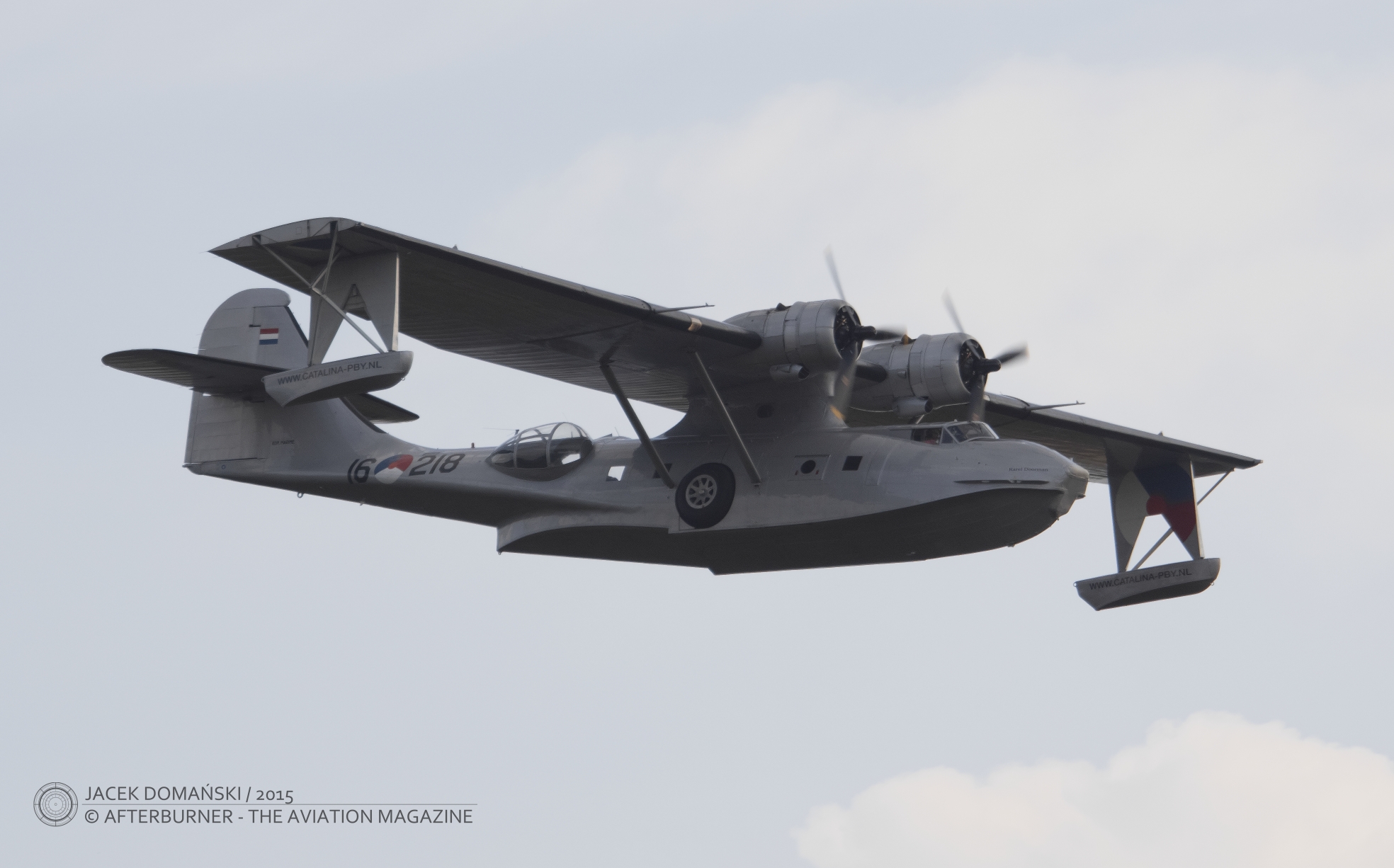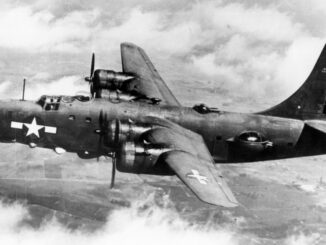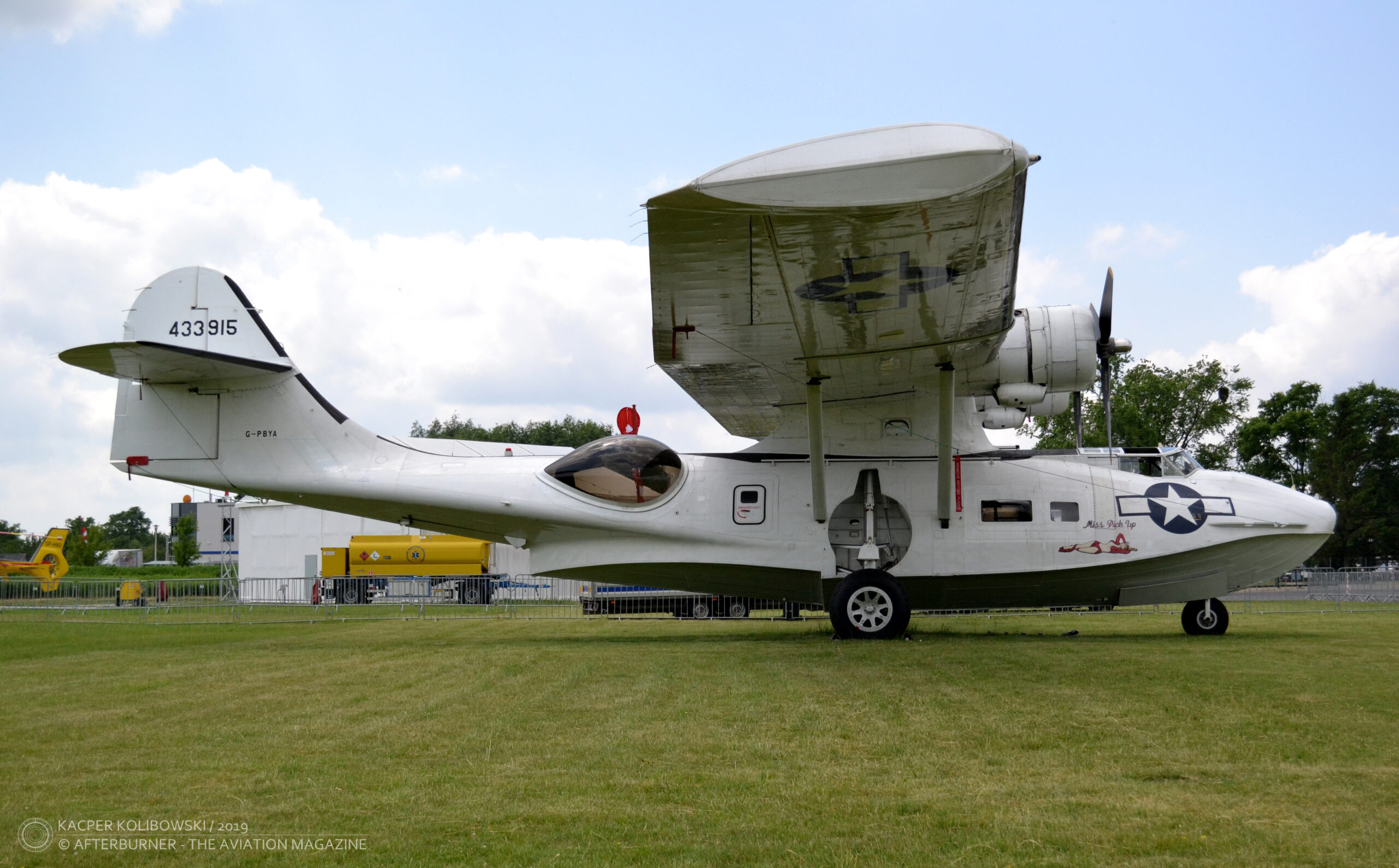
PBY-5A Catalina “Miss Pick Up” (G-PBYA) and one of the crew members – pilot, Mr. Jeff Bouyling, waving his hand for goodbye. The photo was taken on 17th June 2019, just before departure from Płock, where the aeroplane was the biggest star of the Płocki Piknik Lotniczy 2019 (Płock Aviation Picnic 2019).
Sadly, the fatal crash of one of the Yak-52 aerobatic aeroplanes from the Eastside Yaks team, that occurred on Saturday, 15th June (the first day of the event) caused the cancellation of the air show. Despite cancelling the event, on Monday, June 17th, quite a large group of aviation enthusiasts and representatives of the air show organizer have appeared on the Aeroclub of the Masovian Land airfield in Płock, to express their appreciation for participating of the most beautiful flying boat in the world (as Catalina is often described) in the event and say good-bye to the crew. From Płock, the „Miss Pick Up” flew to Kraków for the another Polish air show – XV Małopolski Piknik Lotniczy 2019 (15th Malopolska Aviation Picnic 2019), which will be held on June 22th – 23rd.
The PBY-5A Catalina „Miss Pick Up”, current registration number G-PBYA, has a really interesting history in her already 76 years of career. She was built in 1943 by the Canadian Vickers at Cartierville, Quebec for order of the Royal Canadian Air Force as a Canso A amphibian (Canadian equivalent to the US Navy PBY-5A) and received a constructor number CV-283 and then the RCAF serial number 11005.
The aircraft entered into service on 27th October 1943, being assigned to the 9th Squadron of the RCAF (Bomber Reconnaissance unit), stationed at that time in Bella Bella, on the British Columbia coast. She served in this squadron from November 1943 to August 1944, performing the day and night patrols, looking out for enemy submarines. Soon, the threat of the Japanese invasion on Western Canada has decreased enough, that the 9th Squadron was disbanded and their base at Bella Bella was closed. Then, the 11005 and all the other Cansos that served in the squadron, were transferred to Alliford Bay in the Queen Charlotte Islands, also in British Columbia, where they were assigned to the 7th Squadron (also Bomber Reconnaissance unit) of the Royal Canadian Air Force.
Their task at the new location was the same – searching for enemy submarines. The mentioned aircraft remained in the squadron till the day of the 7th Squadron’s disbandment, on 25th July 1945. With the end of the World War II, the aircraft was stored in Moose Jaw for the next three years. Afterwards, in 1948, 11005 was converted to a freight aeroplane. In that variant, she flew with 413th Survey Squadron (Transport unit) RCAF from Rockcliffe, Ontario, which flew Catalinas in the North Atlantic and Indian Ocean theatres during World War II. After the war, the squadron was re-formed as Photo Reconnaissance and flew photographic reconnaissance missions over the Arctic areas as well as search-and-rescue and flood relief supply flights.
In April 1949, the squadron was once again re-formed to a transport unit. Only for about a year, as it was disbanded in 1950. Next, the 11005 aircraft was assigned to the 121st Flight (Search & Rescue unit) RCAF at Sea Island, Vancouver. At that time, she carried a hull code QT-005. The flying boat finished her military service on 25th May, 1961. After being stored at Vulcan, Alberta, she was finally disposed by the Crown Assets Disposal Corp to the commercial company called Frontier Air Transport, having its base near Calgary. Then she „took off her uniform”, as due to a post-war conversion her bow turret and side blisters were removed and the aeroplane has begun the civilian career.
Despite the fact that the aircraft was bought by the Frontier Air Transport company, there was another company – CANSPEC (aeroplanes of which were performing different tasks, including pest control, freight and fuel hauling, as well as photographic and geophysical survey), that planned to convert her to a water bomber variant for the purpose of firefighting, but eventually it was the Field Aviation company, which installed the internal water tanks in the aircraft. After that, the Canso was taken on by the Kentings company, where she carried a civil registration number CF-NJF. At that time, the flying boat was also chartered to Protection Civile (French operator) with which – basing in Marseille, flew number of years performing firefighting missions from the mid to late 1960’s. At that time, she had a call-sign „Pelican Bleu”, because of livery consisting a blue rear hull band. During her service with French operator, this aeroplane flew at first as F-ZBAY, and later as F-ZBBD. The interesting fact is that the registration number was being changed for a Canadian one, every time the aircraft was returning to Canada.
In the first half of 1970’s, the ‘Canadian Catalina’ joined the firefighting company called Norcanair and was based at Prince Albert in Saskatchewan. Then her livery was changed once again. Despite of changes in colours scheme, now, she received the fleet number 14 in orange, just below the cockpit also. The aircraft’s registration number was changed once more too – from CF-NJF to C-FNJF, a few years later. That was due to a new Canadian regulation concerning aircraft registration numbers.
In the late 90’s, the C-FNJF – together with another Canso previously operated by Norcanair, was assigned to Hicks & Lawrence company and stored for some time at St. Thomas in Ontario. Then, both aircraft were ferried to Nanaimo on Vancouver Island, were they had to be converted into passenger variant for carrying tourist flights in Zimbabwe, by the Catalina Aero Services company. Nevertheless, that never happened and both aircraft remained at Nanaimo. They were put for sale soon after. The C-FNJF was eventually purchased by Plane Sailing Air Displays and then the aeroplane was finally converted into passenger variant. The internal water tanks and other fire-fighting equipment was removed. Passenger seats were installed in their place and additionally the side blisters were exchanged for one-piece smoked Perspex ones, what gave passengers a better panoramic view in the rear part of the hull. Also, a hydraulic air-stairs was put into the rear part of the hull.
The Plane Sailing company bought the C-FNJF with a purpose to replace its original Catalina aircraft. They were considering many aeroplanes of that type. Nevertheless, the choice fell on this one, as her passenger conversion, responded to the company’s expectations the best. When the company bought the flying boat, more long works have been done to prepare her for the long transmission flight to the United Kingdom, as well as for further operations within the company. The process took such a long time, because of all the modifications of the aircraft had to be accepted by Transport Canada. Finally, on 1st March 2004, after tests and familiarisation flights, the Canadian-built Catalina, C-FNJF left Nanaimo and began her journey to the United Kingdom. Through the USA, then Canada again, and finally crossing the Atlantic ocean. Actually, the crew managed to fly over the ocean in second attempt (the first was cancelled due to adverse head-wind conditions). The C-NFJF took off from St. John’s in Canada and after almost thirteen hours, landed in Shannon, in Southern Ireland, on 30th March. Then, the aeroplane flew to the new home base at Duxford.
Yet in 2004, the flying boat took a part in many air shows. On 19th November 2004, when the air show season came to an end, the aircraft underwent an overhaul and was once again re-registered – yet for a British number of G-PBYA with which the Catalina flies to this day.
In May 2005, the G-PBYA was finally repainted in its current livery representing a wartime USAAF OA-10A Catalina 44-33915 of the 8th Air Force 5th Emergency Rescue Squadron, which based at Halesworth, Suffolk. Nowadays, every year, the PBY-5A Catalina “Miss Pick Up” (as she is officially called), being one of only two Catalinas in Europe, participates in many air shows not only in the UK, but in the whole Old Continent, to the delight of aviation enthusiasts. In the end, it must be mentioned, that it’s The Catalina Association organization from the UK, that helps to keep this example of the of the most beautiful flying boat in history of aviation in airworthy condition.



